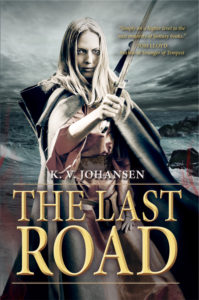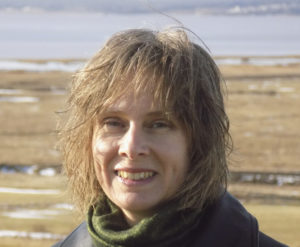Off the Map: How Small Things Create Depth in Space and Time by K.V Johansen
I’ve always been fascinated by maps of places both real and imaginary. Blame The Hobbit and Shepard’s endpapers for The World of Pooh. But it’s not the map that gives a world its breadth and depth; that sense of space, and of time, too, in a story is created in other ways. Middle-earth, a place and a collection of myths and legends and epics never quite finding a final form, had been evolving for years before The Hobbit was sucked into it and what had started off as a children’s fairy-tale adventure struck roots down into something deeper, to grow into the unexpected, The Lord of the Rings. That sense that there is so much more off the map, casting long shadows into the story, is what gives The Lord of the Rings a part of its power. In 1955 readers had no way of finding out anything more of Beren and Luthien, of Gondolin, of Morgoth, of Ungoliant or Thingol, Elbereth or Erendil, beyond a few references: a song, a poem, the narrator’s mention of “some say …” as though of course you, like the characters, will have some faint familiarity with these ancient tales. Readers, before the publication of The Silmarillion, didn’t know that those stories existed as more than a whisper in the author’s mind, and for the story at hand that didn’t matter. What mattered was that their shadows were cast into the present action, the shape of them touching and affecting the unfolding story, and that those fragments and references gave the world a history, an internal frame of reference known, in various forms appropriate to their experience, to the characters.

The physical world, too, is made larger by what lies off the map, expanding outwards from Hobbiton — the wastes where dragons bred in the north, the hobbit lads and lasses who ran away to have adventures, to sail away in ships … other lands exist, and other stories wait. Even on the small and homely level, hints of other stories push at the boundaries of the world. What adventures did Primula Took have, and where, before she settled down to became Mrs Bungo Baggins? Whose story is Merry remembering while the dreams of the barrow still cling to him? What battles were fought on the borders of what would become the Shire, what are those ruined towers, where do the ships sail? (And what artifacts turned up by the hobbits as they ploughed the fields of Eriador were kept in the Michel Delving museum?) We are left certain that the world does not stop at the borders of the drawn map, and that its stories run deep into the past. It is a real world; we are convinced it has grown, not been made up.
A book does not need to have a great legendarium underpinning it, a lifetime’s work awaiting editing and publication, to convey that sense of being only one place and time in a larger geography and history. C.J. Cherryh’s Fortress series does this, though the scope of the action is much more geographically confined, limited to two kingdoms, a river, and uncanny Marna Wood. There are lands beyond that map, though. There is the far cold north, from which the five Sihhë kings were summoned by a Galasieni wizard to rule for a time the lands of Men; there are human kingdoms beyond the borders of Ylesuin that raid and trade and remain a grumbling threat. It is enough to make us believe in the complexity of the world; the politics is not being enacted on an isolated stage, even though the story does not travel beyond the bounds of Ylesuin and Elwynor.
Depth of time, too, is created by details encountered as the story unfolds, not merely by new-made Tristen’s fascination with its passing. What seems a story of politics and a struggle for power between king and lords is gradually revealed through small things to have far more ancient roots. Cefwyn’s grandfather’s fear of the dark and his paranoia spread tendrils into the present action, but only gradually do fragments of history, in remembered tales and written chronicles, begin to give Cefwyn and Tristen, and us with them, the shape of why, and what this has to do with their present situation. Archaeology too, as much as recorded and recalled history, is a strong presence in the Fortress world — ruins have a weight, they define a past but they can also contain ghosts, hold spirits malevolent or protective, and play a part in the present action. They can be a source of power and a fastness against bodiless enemies. Not only stone foundations stretch to connect past and present. A woman may turn out to be a ghost, later, the ghost may be understood to be a spirit, the spirit to be an ancient power in the land, layer upon layer being revealed as the details connect. Only gradually are these stories discovered by Tristen and conveyed to the reader through his growing understanding, expanding our grasp of the world with his. All the mysteries contained in Tristen’s own reincarnated person are central to the story, but they would have less impact if the world were not made big enough to hold both a Tristen and a Barrakkêth, and mysterious enough to contain Galasieni and Sihhë and the possibly non-existent gods, as well as the strong and active spirits of the dead, in addition to ordinary mortal Men. Cherryh never reveals details of these things — with the characters, we assemble only what little lies in human stories, and the broken fragments, mere impressions, that trouble Tristen. The effect of this is to feel that in reading the books, one is exploring a real and living land, learning more of it the longer one spends there. The map and the history grow ever more detailed, as a place takes on layer upon layer of story, becoming what Tristen might think of as a Place, its own story and meaning in the world Unfolding to us through him. The conflict becomes not merely the politics of the present; it is the reckoning of the past reaching thread by thread to surround Tristen from beyond the boundaries of Cefwyn’s down-to-earth here and now.
Through the five books and one short story of Gods of the Caravan Road, my maps kept rolling eastward, then to the south and back to the west, and the story continued to expand, taking in more and more of the world and finding roots in stories of the past that had been, when I wrote them, the merest hints, even to myself. “In the days of the first kings in the north …” it began, the common frame of reference for tales of the seven devils, suggestion of hazy distance in both geography and time. Those words give the story in Blackdog a foundation, a long-ago and far away, but that doesn’t remain something dimly glimpsed on the horizons of the world; Moth rides out of that distance, and the north and the seven devils turn out to be very solid stone under the feet of the story in which Holla-Sayan finds himself, which ran backwards to spin off into “The Storyteller”, set in the north at the time that Moth and Mikki first began their travels together, even as I was writing Blackdog.
Nabban is someplace off the map in the east, when it is first mentioned in Blackdog — maybe only on the other side of the Malagru mountains, for all I knew then. Once I got Ivah to Marakand, I realized it was much farther east than that, and nobody had outright said it wasn’t, so the world flung itself onwards, over the unfolding Praitannec lands and the Five Cities, which turned out to be former Nabbani colonies, some more mountains and deserts — lots of space for more stories to grow out of. Why did Nabban, in the long ago, colonize the shores of the Bay of Taren? Because I’d suggested that Nabbani folk lived there and then found that wasn’t where they’d started, and culturally, they were rather different from what was becoming Imperial Nabban in my mind. So they became colonies in origin — did they revolt or were they abandoned in the chaos after the defeat of Empress Yeh-Lin? That’s the sort of thing that might be a matter of historical interpretation. It doesn’t have to be laid out in detail; the colour that past lends to the story is better achieved as impressionism in watercolour, not precise Flemish oils.
Other small things hint of a larger world. Ahjvar is a great believer in coffee as a treatment for migraine, spiritual angst, and the hangover of possession; I hadn’t yet come to what seemed the right climate for coffee, but obviously there had to be one, off the map somewhere, waiting for the story to need it. It becomes a sketch, implication of trade-routes stretching away, feeding the caravan road, lines flowing off the map, until someone takes ship and the map unfolds beneath them. A Pirakuli tiger-cult is mentioned somewhere along the line, before Ahjvar ever existed, but it seemed the sort of side-story he might run into, and eventually, he does, though we find out about it only in a glancing way. It’s there; someday I may write it. For now, it’s enough for Ghu to tease him about. My armed thunderstorm …
The origins of the wizards who became the seven devils are scattered across the world; only very gradually do those places take on shape, a culture, a history. Why did they go to the north? That’s a question one doesn’t even think to ask, in “The Storyteller”, in Blackdog and Marakand. In Gods of Nabban, one might start to wonder. Yeh-Lin wasn’t a young woman when, a defeated empress, she went to the northwest corner of the continent, to the court of a small king there, and became a devil. She wasn’t a youthful wanderer out for adventure; she went with purpose. But what drew her and the others to Hravnmod’s hall? Not merely curiosity about this folk newly arrived on those shores, chasing the sun east just as Ghu once set out to chase it west. And that small thing, the coming of the first kings in the north, the small detail of Northron magic in a world where every folk-group has their own ways and means of wizardry, turns out to be something of great significance, driving everything in The Last Road. You’d almost think I’d meant to do it all along. But if I’d thought it all up at the beginning, I’d have been very bored. For me, reading and writing are both made far more satisfying by the rumours hinting of what’s beyond the horizon, over those hills, and the scraps of history, the ragged half-remembered or barely-glimpsed things that lie off the map or under the reported histories the characters think they know, waiting to become real through the journey of the story. That’s where the world and the story begin to grow roots and branches and come to life.

Originally from Kingston, Ontario, K.V. Johansen has an M.A. in Medieval Studies from the Centre for Medieval Studies at the University of Toronto and another, in English Literature, from McMaster, where she wrote her thesis on Layamon’s Brut, an Early Middle English epic poem. She’s been writing fantasy since childhood and has a lifelong fascination with history, archaeology, trees, and language. She also plays guitar with great determination and dedication, moderate technical skill, and to her enduring regret, an utter lack of musical talent. In addition to her secondary world fantasy for adults, she is the author of two works on the history of children’s fantasy literature, two short story collections, and a number of books for children and teens, some of which have won awards and various of which have been translated into French, Macedonian, and Danish. She lives in New Brunswick on the Bay of Fundy and spends too much time on Twitter, @kvjohansen. Her website is at www.kvj.ca.







